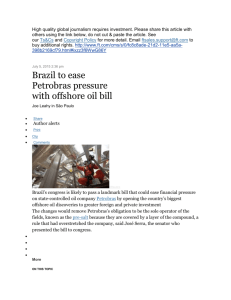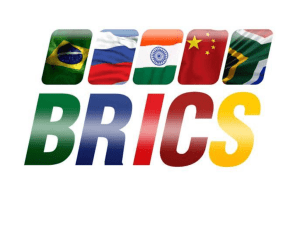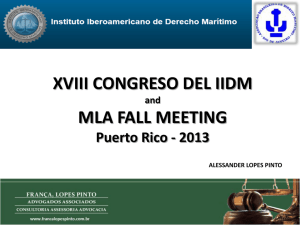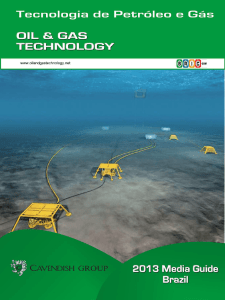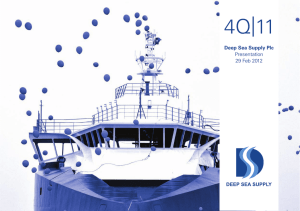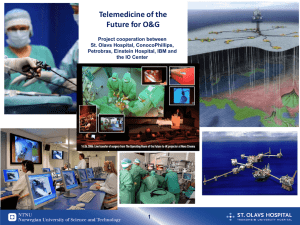Petrobras Case Study
advertisement
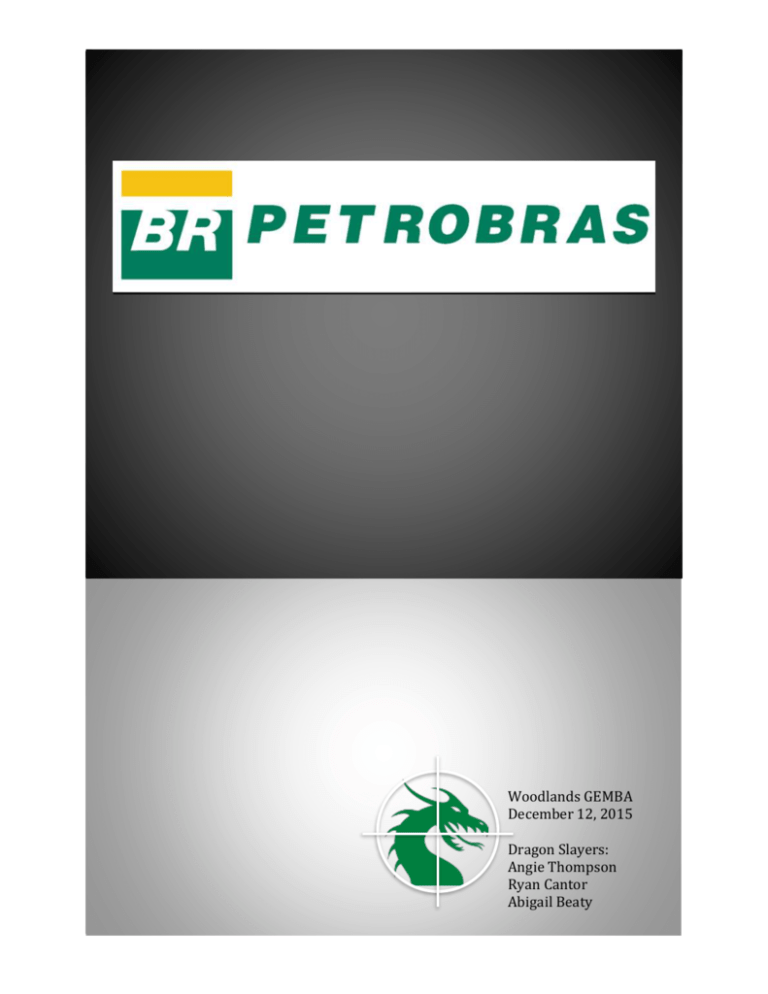
Woodlands GEMBA December 12, 2015 Dragon Slayers: Angie Thompson Ryan Cantor Abigail Beaty Table of Contents Overview ............................................................................................................................. 2 Historic Governance............................................................................................................ 7 Current Leadership ............................................................................................................. 9 Car Wash Scandal.............................................................................................................. 10 Petrobras Reserves Analysis ............................................................................................. 14 Financials........................................................................................................................... 15 Bibliography ...................................................................................................................... 19 Woodlands GEMBA Team Dragon Slayers Petrobras 1 Overview Petrobras is driven by the challenge of supplying the energy that can propel development and ensure the future of the society with competency, ethics, cordiality, and respect for diversity. Petrobras is a publicly traded corporation founded in October 1953 and the majority stockholder is the Federal Government, which is represented by the National Treasury. Petrobra performs as an integrated energy company within the following sectors of Exploration and Production, Refining, Marketing, Transportation, Petrochemicals, Oil product distribution, Natural gas, Electricity, Chemical gas, and Biofuels. Petrobras is considered the leader in the Brazilian oil industry, and has a presence in eighteen countries. In 1961 Petrobras had an important step in refining when REDUC - the Duque de Caxias Refinery - was founded in Rio de Janeiro and in 1963 Cenpes, a research and development center was created in Rio de Janeiro. In 1968 the first platform, the P-I was built as a mobile drilling rig and was able to operate in water of up to 30 meters deep. It was the one that discovered the first oil field in the Brazilian continental shelf, offshore Sergipe, in 1969, giving rise to the Guaricema field. In 1974 there was the discovery in the Campos Basin and years later in 1986, oil in the Amazon was found in the Urucu Field, located in the Solimões River Basin. In 2002, Podium Gasoline was launched at the service stations in Brazil. One of the most significant findings for Petrobras was in 2007 with the discovery of the pre-salt cluster off the Brazilian coast bringing a new horizon for the oil industry worldwide. In 2012, production was Woodlands GEMBA Team Dragon Slayers Petrobras 2 underway at the FPSO Cidade de Anchieta vessel platform, in the Baleia Azul field and in 2013 the pre-salt output reached 300,000 barrels of oil per day. If you ask Petrobras, they focus on sustainable development and they pursue business looking at a long-term perspective. They contribute to economic and social development and to a healthy environment in the communities where they have operations. Petrobras also attempts to maximize collaboration and to seize synergies among teams, areas and units, ensuring an integrated vision of the company in their actions and decisions. They continuously seek to generate value for all stakeholders, reference Figure 1, focusing on capital discipline and on cost management. They very much value and acknowledge, in a differentiated manner, high-performance people and teams. Petrobras cultivates overcoming challenges and seek, relentlessly, to generate and implement innovative technological and business solutions that help their company attain its strategic objectives. Petrobras has five subsidiaries including Distribuidora, Biocombustível, Transpetro, Gaspetro and Liquigás. Petrobras Distribuidora operates in the distribution, trade and manufacturing of oil products and byproducts, in addition to in imports and exports. On the Brazilian streets and roads, the company has upwards of 7,000 service stations, the biggest service station network in Brazil. This subsidiary has more than 10,000 major customers, among industries including but not limited to, thermoelectric plants, aviation companies and light and heavy-duty vehicle fleets. It has been signing-on partnerships Woodlands GEMBA Team Dragon Slayers Petrobras 3 to deploy natural gas-fired thermoelectric power units and programs to optimize product use in respect for the environment. Petrobras Biocombustível was created in 2008, and its mission is to produce biofuels with environmental and social responsibility. This contributes to the diversification of the Brazilian energy matrix and to reduce greenhouse gas emissions, promoting the development of the regions where it operates. This subsidiary is present in all Brazilian regions; it produces biodiesel and ethanol. Petrobras Transpetro undertakes oil and oil products, ethanol, biofuels, and natural gas transportation and storage activities. It is in charge of more than 14,000 kilometers of pipelines; among oil pipelines and gas pipelines which interconnect all Brazilian regions and supply the country's most remote points. In addition to the pipeline network, there are also terminals and a fleet of oil tankers, joining forces with Petrobras' production, refining, and distribution areas. Petrobras Gaspetro is directly related to the enhancement of the natural gas supply nationwide. From Corumbá near the Bolivia-Brazil border to the city of Uruguaiana, in Rio Grande do Sul, the company counts on a gas pipeline network, belonging to Petrobras, that ranges for more than 7,000 kilometers. This network runs under the Brazilian soil, crossing through states and taking natural gas, via state distributing companies, to homes, industries, plants, and automotive vehicles. It also allows the company to operate in another important segment: telecommunications, a service that uses cutting-edge technology and is required by major companies all over the world. The last subsidiary, Liquigás Distribuidora operates in the bottling, distribution, and sale of liquefied petroleum gas (LPG). It is the leader of the Brazilian market of gas bottles of up to 13 kg - commonly Woodlands GEMBA Team Dragon Slayers Petrobras 4 used in homes for cooking food, our subsidiary supplies about 8.5 million homes and more than 35,000 customers in the bulk segment monthly. One of the largest LPG distributors in Brazil, it also provides products and services tailored to various sectors, such as industry, trade, agriculture and livestock. Present in 23 Brazilian states, Liquigás has a network of approximately 4,800 authorized resellers. Figure 1: Woodlands GEMBA Team Dragon Slayers Petrobras 5 Woodlands GEMBA Team Dragon Slayers Petrobras 6 Historic Governance Unlike other NOCs, Petrobras did not begin due to rich oil reserves. As the internal exploration and infrastructure were established beginning in 1954, “frugality and ingenuity” were prized descriptors of the new company’s leadership in the early days. For this reason, Petrobras top managers were selected from the military, whose disciplined culture was soon exemplified by the company. Modeling themselves after efficient IOCs, “Petrobras top managers organized the company to operate as an integrated oil company, with multiple divisions and a central executive board.” (Victor, Hults and Thurber) There was much political strife regarding both how Petrobras was managed and how revenues were derived. Following a military coup in 1964, Petrobras “stopped revealing much about its international operations or affairs to the public.” In 1968, under the leadership of General Ernesto Geisel, Petrobras expanded with the creation of four new subsidiaries that would enable the verticalization of the company, as well as spread the influence of the company into the most important sectors of the Brazilian economy. (Victor, Hults and Thurber) Although Petrobras nearly went bankrupt during the 1973 oil crisis, the discovery of the Bacia de Campos oil field in 1975 saved it’s finances and helped it restructure nationwide. Petrobras began signing contracts with private oil companies to explore more oil fields throughout Brazil. Woodlands GEMBA Team Dragon Slayers Petrobras 7 As the country moved towards democracy in the late 1980s, the idea of privatization of Petrobras was a political hot topic, with promises of privatization and market liberalization by incoming Presidents. The total privatization of Petrobras proved impossible, but the liberalization of the oil market moved forward in 1995 as “the government ended the Petrobras monopoly over hydrocarbon resources and retained, for itself, the right of these resources.” (Victor, Hults and Thurber) The establishment of the National Petroleum Agency (ANP) created a level field for payment to the government following the discovery of new fields, with the aim of exposing Petrobras to new competition. Share of Petrobras were sold to private investors, but to satisfy nationalists, the government retained the majority stock. “Petrobras accepted these new policies because they removed the government’s control over pricing of oil products.” In spite of the changes, Petrobras continued to maintain its monopoly in the domestic market. (Victor, Hults and Thurber) In 2010, following the major discovery of strategic reserves, including pre-salt, the Brazilian government created Pré-Sal Petróleo S.A. (PPSA) or “Petrossal”, a subsidiary of Petrobras. It’s important to note that Petrossal is a government-appointed administration, not an oil company. The goal of Petrossal was to oversee productionsharing contracts for the country's “strategic areas” or pre-salt blocks. Under Brazil's oil and gas regulatory framework, Petrobras must hold a 30% operating stake in all pre-salt Woodlands GEMBA Team Dragon Slayers Petrobras 8 blocks. In addition, a minimum 42% of oil produced must be ceded to the federal government, which in turn has pledged to inject the revenue into education and health. (BN Americas) With substantial and potentially lucrative discoveries of the early 2000s, this creates a big departure from the previous relationship between Petrobras and the Brazilian government. In the past, “Petrobras thrived because it successfully sought autonomy and because it faced a scarcity of capital and other resources…Today, the perception of oil scarcity has disappeared and the governments’ appetite for oil revenues has increased spectacularly, moving the set of preferences of the government far away from where it was at the time of Petrobras’ founding.” (Victor, Hults and Thurber) Current Leadership Petrobras is currently lead by CEO Aldemir Bendine. Bendine was formerly the head of state-owned bank Banco do Brasil. Mr. Bendine took the helm after Maria das Graças Silva Foster resigned along with five other senior executives in the midst of the pricefixing and skimming scandal that’s been plaguing the company since Feb 2014. The CEO role at Petrobras is largely a political post. Brazil’s President, Dilma Rouseff, appoints most of the board members, who then approve the CEO. Feelings on Bendine’s appointment are mixed, with independent board members complaining that the new CEO represents little more than a political appointment. Woodlands GEMBA Team Dragon Slayers Petrobras 9 While views on Bendine’s performance at Banco do Brasil are mostly favorable – the bank showed rich profits and kept the default rate under control during his 30-year tenure, there is vast concern that he shows little technical knowledge in the oil and gas industry. (Jelmayer and Gagalhaes) But the reality is that Petrobras is currently the most indebted oil company in the world. Time will tell if this banker can right the ship as the Petrobras scandal continues to unfold. Car Wash Scandal On March 20, 2014, as part of “Operation Car Wash,” Brazilian federal police arrested the former head of Petrobras' refining and supply department, Paulo Roberto Costa. The arrest was the result of an investigation that started when they noticed Costa had been given a Range Rover car by convicted black-market moneychanger Alberto Youssef. Over the next two years, prosecutors and federal police in Brazil would unearth the country's largest-ever corruption scandal by linking a ring of black-market moneychangers to a price-fixing and political kickback scheme at state-run oil company Petrobras. “Executives from two dozen engineering firms are accused of inflating the value of contracts and funneling the excess funds into their own bank accounts and to political parties, including President Dilma Rousseff's Workers' Party.” (Stauffer) Woodlands GEMBA Team Dragon Slayers Petrobras 10 Key events in the investigation include the following: December 11, 2014: Prosecutors in Curitiba formally charged 36 people, 22 of them from engineering firms OAS, Camargo Correa, UTC Engenharia, Galvao Engenharia, Mendes Junior and Engevix. Additionally, Prosecutor Deltan Dallagnol declares war on corruption in Brazil in a nationally televised press conference. February 6, 2015: Aldemir Bendine, former head of state-run Banco do Brasil SA, steps in as Petrobras CEO after Maria das Graças Foster and other senior executives resign abruptly. It’s interesting to note that on Petrobras’ website, they have a downloadable PDF called Petrobras Corruption Prevention Program which still contains a message from the previous CEO of Petrobras, Maria das Graças Silva Foster, who stepped down along with other key executives in the middle of the federal investigation. No charges have been filed against her to date. March 6, 2015: Brazil's Supreme Court says it will investigate the speakers of both houses of Congress and 32 other sitting politicians in connection with the Petrobras scheme. Twelve senators and 22 congressmen from five parties are under investigation, all but one from President Rousseff's governing coalition. Woodlands GEMBA Team Dragon Slayers Petrobras 11 April 22, 2015: The first arrestee, Paulo Roberto Costa, is sentenced to a little over seven years in prison, but will only serve one year of house arrest due to his collaboration and time already spent in detention. A total of eight people are convicted in the probe's first sentences. May 26, 2015: Nestor Cervero, former international director of Petrobras, is sentenced to five years in jail for money laundering. June 19, 2015: Brazilian police arrest the chief executives of the country's two largest construction companies, Marcelo Odebrecht, head of family-run conglomerate Odebrecht SA, and Otavio Marques Azevedo, CEO of Andrade Gutierrez. Prosecutors say the companies led the cartel of engineering firms. July 14, 2015: Federal police carry out search and seizure operations at the home of Senator and former President Fernando Collor de Mello, the first such operation targeting a sitting politician. From July to today, prosecutors continue to present formal charges against government officials, Petrobras executives and the executives from engineering and construction firms, all who appear to have colluded to line their own pockets. (Stauffer) Woodlands GEMBA Team Dragon Slayers Petrobras 12 Total monies skimmed from Petrobras to date are estimated at over $3 billion US dollars (roughly $10 billion Brazilian reis). The cost to Petrobras as a company is estimated at over $100 billion USD. As of March 2015, 57 politicians and senior officials from all sides of the political spectrum have been named in the scandal. The outcome is that the country is paying the price. Many workers have been laid off, worker housing closed, major construction projects halted, more than 200 companies involved have lost credit lines, and the Brazilian congress is paralyzed. (Watts) Just this week (Dec. 2, 2015), Brazil’s congress has initiated impeachment hearings against President Dilma Roussef, who was narrowly reelected in January 2014. Her second term has been plagued by the Petrobras scandal, but no wrongdoing has been linked directly to her to date, although high-ranking members of her party have been implicated. (Bevins) As lower house leader Eduardo Cunha spearheaded the call for impeachment, he is simultaneously being investigated for hiding millions in Swiss bank accounts. His call for impeachment is seen by some as a last ditch effort to smear Rouseff’s name and divert attention from himself. President Rouseff maintains that, “There are no rumors that I have diverted public funds, I have no bank account abroad, and I didn't hide any personal property from the public.” (Bevins) Woodlands GEMBA Team Dragon Slayers Petrobras 13 Petrobras Reserves Analysis The reserve picture for Petroleo Brasileiro SA (Petrobras) can only be characterized by the word anemic. Ending 2014, Petrobras’ reserves grew at the slowest rate in six years with new discoveries barely matching the production decline curve. As of Dec 31, 2014, the company claimed 13 BBOE. This constituted an almost non-existent increase from the previous year of just 0.1 percent. Over the last decade, they have averaged 2.3 percent annual growth. Clearly things are going in the wrong direction from a reserve replacement/growth perspective. Reuters (Blount, Jan 2015) gives some perspective on the cause of the decline: “The sluggish growth is the latest in a series of failures by company executives and its main shareholder, the Brazilian government, to deliver on promises about the benefits that will flow from giant offshore oil resources discovered starting in 2006.” Incredibly this paltry growth has been achieved under an era of massive spending. Petrobras has committed to spending $44.2Bn on capital investments per year through 2017 making it one of the world’s largest investment programs. Again Reuters comments on this in stark language: “But as spending has soared, production has lagged expectations. Petrobras has missed output targets every year for more than a decade, helping make it the world's most indebted and least profitable major oil company.” Woodlands GEMBA Team Dragon Slayers Petrobras 14 Of course all of these problems could be rendered meaningless in the years to come. As mentioned previously, the Libra field is the largest oil field ever discovered in Brazil. If they can overcome their internal dysfunction and strife, they likely won’t have to worry about reserves for at least a generation. Financials During much of the last reporting period, the Real depreciated significantly. As you can see below it dropped almost 62% against the USD. This of course coincided with a precipitous drop in oil prices. Brent crude fell 48% during this period. These two uncontrollable factors will be a theme throughout Woodlands GEMBA Team Dragon Slayers Petrobras 15 Petrobras’ latest financial status report. Total financial results at the time of reporting compared to the same period in 2014 were R$-23.1B. This was in large part due to higher exchange rate loss on foreign currency debt and higher financial expenses due to the increase in debt. All together the net income was R$2.1B compared with R$5B during the same period in 2014. Operational expenses went up for the 3Q as well. Some of this can be attributed to higher dry well costs (See table). Woodlands GEMBA Team Dragon Slayers Petrobras 16 These are not favorable numbers especially considering the fact that Petrobras produced as much or more oil this year than ever before. The Pre-salt discoveries are going strong, they will continue to prop up declining production, inferior cost control, and mismanagement issues. Here are additional key financial highlights (Yahoo Finance): Financial Highlights Fiscal Year Fiscal Year Ends: Dec 31 Most Recent Quarter (mrq): Sep 30, 2015 Profitability Profit Margin (ttm): -7.62% Operating Margin (ttm): 10.86% Management Effectiveness Return on Assets (ttm): 2.50% Return on Equity (ttm): -8.38% Income Statement Revenue (ttm): 86.80B Revenue Per Share (ttm): 13.31 Qtrly Revenue Growth (yoy): -6.90% Gross Profit (ttm): 34.18B EBITDA (ttm)6: 22.83B Net Income Avl to Common (ttm): -6.61B Diluted EPS (ttm): -1.01 Qtrly Earnings Growth (yoy): N/A Balance Sheet Total Cash (mrq): 28.14B Total Cash Per Share (mrq): 4.31 Total Debt (mrq): 136.73B Total Debt/Equity (mrq): 174.10 Current Ratio (mrq): 1.61 Woodlands GEMBA Team Dragon Slayers Petrobras 17 Book Value Per Share (mrq): 11.98 Cash Flow Statement Operating Cash Flow (ttm): 20.54B Levered Free Cash Flow (ttm): -3.01B Woodlands GEMBA Team Dragon Slayers Petrobras 18 Bibliography Bevins, Vincent. Brazil President Dilma Rousseff faces impeachment proceedings. 2 December 2015. <http://www.latimes.com/world/mexico-americas/la-fg-brazilrousseff-20151202-story.html>. BN Americas. Pré-Sal Petróleo S.A. <http://www.bnamericas.com/companyprofile/en/pre-sal-petroleo-sa-ppsa>. Jelmayer, Rogerio and Luciana Gagalhaes. Banker Takes Helm of Brazil's Troubled Oil Giant. 6 Feb 2015. <http://www.wsj.com/articles/bancodobrasilchiefunderconsiderationfortoppetrobrasp ost1423229592>. Petrobras Corporate Website. 07 12 2015. 07 12 2015 <http://www.petrobras.com/en/about-us/global-presence/>. Stauffer, Caroline. TIMELINE-Key moments in Brazil's Petrobras corruption probe. 14 Aug 2015. <http://www.reuters.com/article/brazil-petrobrasidUSL1N10O31F20150814#XUG3dfkZ0lgYLu2Q.97>. Victor, David, David Hults and Mark Thurber. Oil and Governance: State-owned Enterprises and the World Energy Supply. Cambridge: Cabridge University Press, 2012. Watts, Jonathan. Brazil elite profit from $3bn Petrobras scandal as laid-off workers pay the price. 20 March 2015. <http://www.theguardian.com/world/2015/mar/20/brazilpetrobras-scandal-layoffs-dilma-rousseff>. Woodlands GEMBA Team Dragon Slayers Petrobras 19

